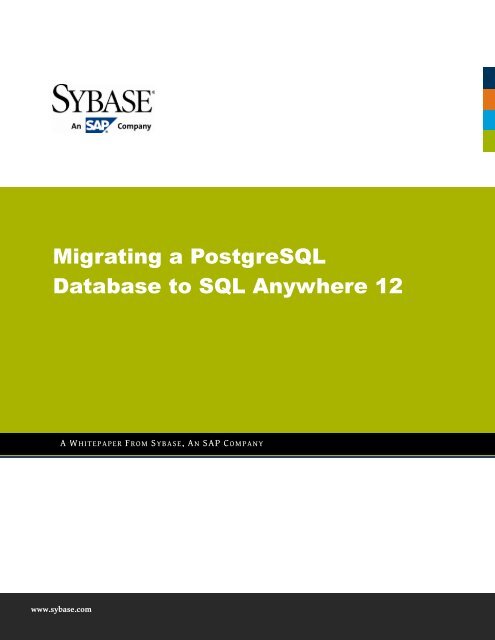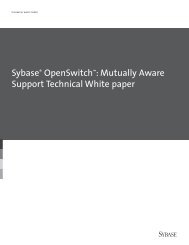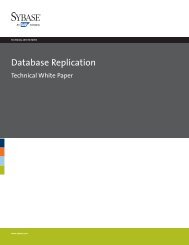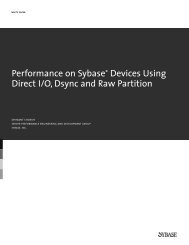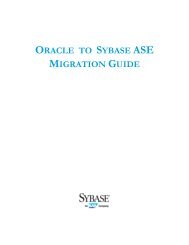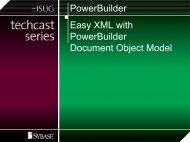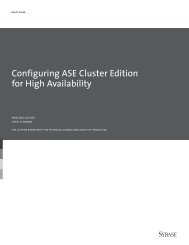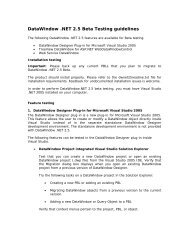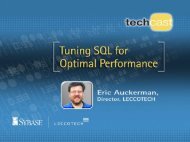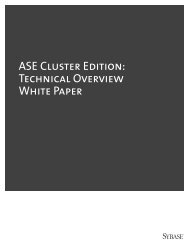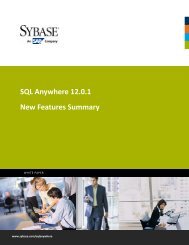Migrating a PostgreSQL Database to SQL Anywhere 12 - Sybase
Migrating a PostgreSQL Database to SQL Anywhere 12 - Sybase
Migrating a PostgreSQL Database to SQL Anywhere 12 - Sybase
Create successful ePaper yourself
Turn your PDF publications into a flip-book with our unique Google optimized e-Paper software.
<strong>Migrating</strong> a <strong>Postgre<strong>SQL</strong></strong><br />
<strong>Database</strong> <strong>to</strong> <strong>SQL</strong> <strong>Anywhere</strong> <strong>12</strong><br />
A W HITEPAPE R F ROM S YBAS E, AN SAP CO M PA NY<br />
www.sybase.com
Contents:<br />
Introduction .................................................................................................................................................... 2<br />
Differences between <strong>Postgre<strong>SQL</strong></strong> 9.1 and <strong>SQL</strong> <strong>Anywhere</strong> <strong>12</strong>...................................................................... 3<br />
Data types ...................................................................................................................................................................... 3<br />
<strong>Postgre<strong>SQL</strong></strong> function mappings <strong>to</strong> <strong>SQL</strong> <strong>Anywhere</strong> ................................................................................................... 6<br />
Aggregate Functions .................................................................................................................................................... 7<br />
String Functions ........................................................................................................................................................... 7<br />
Numeric Functions ....................................................................................................................................................... 3<br />
Date and Time Functions ............................................................................................................................................. 3<br />
Syntax Mappings .......................................................................................................................................................... 2<br />
Opera<strong>to</strong>rs ....................................................................................................................................................................... 2<br />
Data Manipulation Language ...................................................................................................................................... 2<br />
Miscellaneous Syntax .................................................................................................................................................. 3<br />
Other migration issues ................................................................................................................................................ 4<br />
<strong>Migrating</strong> a <strong>Postgre<strong>SQL</strong></strong> database <strong>to</strong> a <strong>SQL</strong> <strong>Anywhere</strong> database ............................................................... 6<br />
Requirements ................................................................................................................................................................ 6<br />
Creating a <strong>SQL</strong> <strong>Anywhere</strong> database ........................................................................................................................... 6<br />
Creating a data source for the <strong>Postgre<strong>SQL</strong></strong> database ............................................................................................... 6<br />
<strong>Migrating</strong> the <strong>Postgre<strong>SQL</strong></strong> database <strong>to</strong> <strong>SQL</strong> <strong>Anywhere</strong> ............................................................................................ 7<br />
Connecting <strong>to</strong> the <strong>SQL</strong> <strong>Anywhere</strong> <strong>Database</strong> .......................................................................................................... 7<br />
Creating a Remote Server and External Login...................................................................................................... 7<br />
<strong>Migrating</strong> the <strong>Postgre<strong>SQL</strong></strong> database ....................................................................................................................... 9<br />
Tweaking the new <strong>SQL</strong> <strong>Anywhere</strong> database ........................................................................................................... 10<br />
<strong>Migrating</strong> applications from <strong>Postgre<strong>SQL</strong></strong> <strong>to</strong> <strong>SQL</strong> <strong>Anywhere</strong> .................................................................... <strong>12</strong><br />
<strong>Migrating</strong> a PYTHON application from <strong>Postgre<strong>SQL</strong></strong> <strong>to</strong> <strong>SQL</strong> <strong>Anywhere</strong> ................................................................ <strong>12</strong><br />
<strong>Migrating</strong> a Perl application from <strong>Postgre<strong>SQL</strong></strong> <strong>to</strong> <strong>SQL</strong> <strong>Anywhere</strong> ........................................................................ <strong>12</strong><br />
<strong>Migrating</strong> a PHP application from <strong>Postgre<strong>SQL</strong></strong> <strong>to</strong> <strong>SQL</strong> <strong>Anywhere</strong> ....................................................................... 13<br />
Function mapping .................................................................................................................................................. 13<br />
PHP migration notes .............................................................................................................................................. 14<br />
Summary ........................................................................................................................................................ 15<br />
<strong>Migrating</strong> a <strong>Postgre<strong>SQL</strong></strong> <strong>Database</strong> <strong>to</strong> <strong>SQL</strong> <strong>Anywhere</strong> <strong>12</strong><br />
December 2011<br />
i
Introduction<br />
<strong>Migrating</strong> data from <strong>Postgre<strong>SQL</strong></strong> <strong>to</strong> <strong>SQL</strong> <strong>Anywhere</strong> can be a straightforward process if there are not a lot of<br />
<strong>Postgre<strong>SQL</strong></strong> extensions in use within your database and application. <strong>SQL</strong> <strong>Anywhere</strong> simplifies migration by<br />
including built-in <strong>to</strong>ols that facilitate a smooth transition from <strong>Postgre<strong>SQL</strong></strong> (and other RDBMS’s) <strong>to</strong> <strong>SQL</strong><br />
<strong>Anywhere</strong>.<br />
The first part of this document discusses in detail differences between <strong>SQL</strong> <strong>Anywhere</strong> and <strong>Postgre<strong>SQL</strong></strong>,<br />
including data type differences, feature differences, and syntax differences. Some of the features that are<br />
unique <strong>to</strong> <strong>Postgre<strong>SQL</strong></strong> can hinder migration. Approaches <strong>to</strong> how you might choose <strong>to</strong> deal with these issues are<br />
provided. The second part of this document includes a systematic explanation of how <strong>to</strong> migrate data from a<br />
<strong>Postgre<strong>SQL</strong></strong> database in<strong>to</strong> a <strong>SQL</strong> <strong>Anywhere</strong> database using the <strong>Sybase</strong> Central Data Migration wizard. Finally,<br />
the third part of this document supplies an example of how you might migrate an existing application running<br />
against <strong>Postgre<strong>SQL</strong></strong> <strong>to</strong> one that runs against <strong>SQL</strong> <strong>Anywhere</strong>.<br />
This document was written for <strong>SQL</strong> <strong>Anywhere</strong> version <strong>12</strong> and later, and <strong>Postgre<strong>SQL</strong></strong> version 9.1 and later.<br />
<strong>Migrating</strong> a <strong>Postgre<strong>SQL</strong></strong> <strong>Database</strong> <strong>to</strong> <strong>SQL</strong> <strong>Anywhere</strong> <strong>12</strong><br />
December 2011<br />
2
Differences between <strong>Postgre<strong>SQL</strong></strong> 9.1 and <strong>SQL</strong> <strong>Anywhere</strong> <strong>12</strong><br />
The following sections describe some of the differences between <strong>Postgre<strong>SQL</strong></strong> and <strong>SQL</strong> <strong>Anywhere</strong> that you may<br />
encounter during migration, along with some suggested solutions that can be used as starting points <strong>to</strong> resolve<br />
any issues that arise during migration. There are many ways <strong>to</strong> optimize your code with <strong>SQL</strong> <strong>Anywhere</strong><br />
features that are missing from <strong>Postgre<strong>SQL</strong></strong>.<br />
It is highly recommended that you review the <strong>SQL</strong> <strong>Anywhere</strong> documentation as well as the developer<br />
resources, including samples and technical documents, available on the <strong>SQL</strong> <strong>Anywhere</strong> Tech Corner website at<br />
http://www.sybase.com/developer/library/sql-anywhere-techcorner when moving <strong>to</strong> <strong>SQL</strong> <strong>Anywhere</strong>.<br />
Data types<br />
In most cases, the <strong>Postgre<strong>SQL</strong></strong> data types can map directly <strong>to</strong> <strong>SQL</strong> <strong>Anywhere</strong> data types. The following table<br />
lists some examples:<br />
<strong>Postgre<strong>SQL</strong></strong> data type Equivalent <strong>SQL</strong> <strong>Anywhere</strong> data type Notes<br />
BIGINT<br />
BIGINT<br />
BIGSERIAL BIGINT With a default system-defined<br />
au<strong>to</strong>increment value<br />
BIT<br />
BIT<br />
BIT VARYING(n) VARBIT(n) In <strong>SQL</strong> <strong>Anywhere</strong>, length is 1 by<br />
default<br />
BIT VARYING<br />
BOOLEAN<br />
LONG VARBIT<br />
TINYINT OR BIT<br />
BOX ST_POLYGON(ST_POINT, ST_POINT) The two ST_POINTS represent the<br />
lower-left and upper right corners<br />
BYTEA<br />
LONG BINARY<br />
CHARACTER VARYING(n) VARCHAR(n CHAR) Length in characters must be<br />
defined<br />
CHARACTER(n) CHAR(n CHAR) Length in characters must be<br />
defined<br />
CIDR N/A No equivalence<br />
CIRCLE ST_CIRCULARSTRING(ST_POINT, ...)<br />
DATE<br />
DOUBLE PRECISION<br />
DATE<br />
DOUBLE<br />
INET N/A No equivalence<br />
<strong>Migrating</strong> a <strong>Postgre<strong>SQL</strong></strong> <strong>Database</strong> <strong>to</strong> <strong>SQL</strong> <strong>Anywhere</strong> <strong>12</strong><br />
December 2011<br />
3
INTEGER<br />
INTEGER<br />
INTERVAL INTEGER Can be converted <strong>to</strong> date format<br />
LINE N/A No equivalence<br />
LSEG ST_LINESTRING(ST_POINT, ...)<br />
MACADDR N/A No equivalence<br />
MONEY<br />
NUMERIC<br />
MONEY<br />
NUMERIC<br />
PATH(open) ST_LINESTRING(ST_POINT, ...)<br />
PATH(closed) ST_POLYGON(ST_POINT, ...)<br />
POINT<br />
ST_POINT<br />
POLYGON ST_POLYGON(ST_POINT, ...)<br />
REAL<br />
SMALLINT<br />
FLOAT<br />
SMALLINT<br />
SERIAL INTEGER With a default system-defined<br />
au<strong>to</strong>increment value<br />
TEXT<br />
TIME<br />
TEXT<br />
TIME<br />
TIME WITH TIME ZONE N/A Timestamp with timezone<br />
TIMESTAMP<br />
TIMESTAMP WITH TIME ZONE<br />
TIMESTAMP<br />
TIMESTAMP WITH TIME ZONE<br />
TSQUERY N/A No equivalence<br />
TSVECTOR N/A No equivalence<br />
TXID_SNAPSHOT N/A No equivalence<br />
UUID<br />
XML<br />
UNIQUEIDENTIFIER<br />
XML<br />
Note: In addition <strong>to</strong> the differences in data types themselves, there is also a difference in the declaration of<br />
data types. <strong>Postgre<strong>SQL</strong></strong> provides an optional parameter for its numeric types that allow you <strong>to</strong> specify the<br />
maximum display width for integer types. For example, an INT(4) column would return the value ‘1’ as<br />
‘1’, where is a space. The optional ZEROFILL modifier on the type definition would replace the<br />
4 <strong>Migrating</strong> a <strong>Postgre<strong>SQL</strong></strong> <strong>Database</strong> <strong>to</strong> <strong>SQL</strong> <strong>Anywhere</strong> <strong>12</strong><br />
December 2011
spaces in the previous example with zeros and add the UNSIGNED attribute <strong>to</strong> the column. For example, ‘1’ is<br />
returned as ‘0001’. The merge of display format and data values in the type definition is not supported by <strong>SQL</strong><br />
<strong>Anywhere</strong>. The CAST and CONVERT functions, along with the various string manipulation functions are<br />
available <strong>to</strong> format data values when they are retrieved from the database.<br />
The following data types differ from <strong>SQL</strong> <strong>Anywhere</strong> more substantially than by syntax:<br />
MEDIUMINT: These are 3-byte integer values. They can easily be simulated using an INTEGER (4 bytes) or<br />
SMALLINT (2 bytes) in <strong>SQL</strong> <strong>Anywhere</strong>, depending on the expected range of values for the column.<br />
YEAR: Year is a 2 or 4 digit value. The <strong>SQL</strong> <strong>Anywhere</strong> DATE data type can be used <strong>to</strong> hold year values, but uses<br />
slightly more s<strong>to</strong>rage space. Date arithmetic and conversion can be performed using the <strong>SQL</strong> <strong>Anywhere</strong> builtin<br />
functions listed under “Date and Time Functions” in the “<strong>SQL</strong> Functions” chapter of the “<strong>SQL</strong> <strong>Anywhere</strong><br />
Server - <strong>SQL</strong> Reference” manual.<br />
The following data types do not match exactly, and will require some work <strong>to</strong> migrate <strong>to</strong> <strong>SQL</strong> <strong>Anywhere</strong>:<br />
NCHAR/NVARCHAR: As of <strong>Postgre<strong>SQL</strong></strong> 5, an NCHAR value is s<strong>to</strong>red in <strong>Postgre<strong>SQL</strong></strong> using the UTF8 character set.<br />
<strong>SQL</strong> <strong>Anywhere</strong> supports a variety of character sets, including UTF8. With a database created using the proper<br />
collation, the use of a special data type <strong>to</strong> s<strong>to</strong>re international values is not required, though <strong>SQL</strong> <strong>Anywhere</strong> does<br />
support the NCHAR data type. To learn more about the latest international character set support in <strong>SQL</strong><br />
<strong>Anywhere</strong>, see the chapter “International Language and Character Sets” in the “<strong>SQL</strong> <strong>Anywhere</strong> Server -<br />
<strong>Database</strong> Administration” manual.<br />
ENUM: An ENUM value is a string object whose value must be chosen from a list of supplied values enumerated<br />
in the column definition when a table is created. The enumerated values can also be inserted or retrieved by<br />
their index position in the ENUM definition. The index value 0 is reserved for the empty string. The ENUM<br />
data type is represented in <strong>SQL</strong> <strong>Anywhere</strong> by a TINYINT column. There are a few options <strong>to</strong> accomplish the<br />
same behavior as the <strong>Postgre<strong>SQL</strong></strong> ENUM, but changes <strong>to</strong> the client application will almost certainly be required.<br />
Some options are:<br />
• Altering the client side application <strong>to</strong> remove the need for ENUM values<br />
• Translating the ENUM values on the client side<br />
• Adding some logic <strong>to</strong> the server side <strong>to</strong> attempt <strong>to</strong> mimic the <strong>Postgre<strong>SQL</strong></strong> behavior of ENUM values<br />
by using s<strong>to</strong>red procedures, triggers, computed columns, view, and/or a mapping table for the<br />
ENUM types<br />
For example, a view could be created on the table containing the ENUM fields <strong>to</strong> allow for the return of the<br />
values as a string, while a regular SELECT could be used <strong>to</strong> return them as a number. Here is an example of a<br />
view that could be used:<br />
CREATE TABLE enumtbl (pkey INTEGER NOT NULL PRIMARY KEY, enumval TINYINT);<br />
CREATE VIEW v_enumtable AS<br />
SELECT pkey<br />
CASE WHEN 0 then ‘’<br />
WHEN 1 then ‘val1’<br />
WHEN 2 then ‘val2’<br />
WHEN 3 then ‘val3’<br />
ELSE NULL<br />
END<br />
FROM enumtbl;<br />
Then, a query may look something like this:<br />
SELECT pkey, enumval FROM v_enumtable;<br />
Alternatively, a mapping table could be created for the ENUM vales and whenever you retrieve data from<br />
enumtbl, a join can be made <strong>to</strong> the mapping table containing the ENUM strings.<br />
<strong>Migrating</strong> a <strong>Postgre<strong>SQL</strong></strong> <strong>Database</strong> <strong>to</strong> <strong>SQL</strong> <strong>Anywhere</strong> <strong>12</strong><br />
December 2011<br />
5
CREATE TABLE enummap( enumval TINYINT NOT NULL PRIMARY KEY, enumstr CHAR(16));<br />
Then a query may look something like this:<br />
SELECT pkey, enumval FROM enumtbl, enummap<br />
WHERE enumtbl.enumval = enummap.enumval;<br />
An insert on the table can be done directly if you are using the index values of the ENUM; otherwise, a s<strong>to</strong>red<br />
procedure could be used <strong>to</strong> insert a row in<strong>to</strong> any table containing an ENUM. The s<strong>to</strong>red procedure would<br />
contain the logic <strong>to</strong> decode the ENUM values. Following is a sample s<strong>to</strong>red procedure implementation <strong>to</strong> deal<br />
with an ENUM column equivalent in <strong>SQL</strong> <strong>Anywhere</strong> (using the same table definition as above):<br />
CREATE PROCEDURE sp_insert_enumval (IN pkeyval int, IN enum CHAR(16))<br />
BEGIN<br />
DECLARE enum_map TINYINT;<br />
IF enum IS NOT NULL THEN<br />
CASE enum<br />
WHEN ‘’ THEN SET enum_map = 0<br />
WHEN ‘val1’ THEN SET enum_map = 1<br />
WHEN ‘val2’ THEN SET enum_map = 2<br />
WHEN ‘val3’ THEN SET enum_map = 3<br />
ELSE SET enum_map = 0<br />
END CASE<br />
END IF;<br />
INSERT INTO enumtbl VALUES( pkeyval, enum_map);<br />
END<br />
SET: A SET value is a string object whose value must be chosen from a list of values supplied when the column<br />
is defined. It is different from the ENUM type in that 0 or more values from the list can be combined <strong>to</strong> create a<br />
valid value for the column. Each value in the set is assigned a binary value and data can be assigned or<br />
retrieved by using a number representing the combination of values <strong>to</strong> be set. For example, specifying a value<br />
of 9 would insert the first and fourth value from the set in<strong>to</strong> the column. Depending on how many values are<br />
in the set (64 is maximum), anything from a TINYINT <strong>to</strong> a BIGINT is required <strong>to</strong> map a SET value from<br />
<strong>Postgre<strong>SQL</strong></strong> <strong>to</strong> <strong>SQL</strong> <strong>Anywhere</strong>. To achieve the same behavior as <strong>Postgre<strong>SQL</strong></strong>, methods similar <strong>to</strong> those<br />
demonstrated above with the ENUM data type can be used.<br />
<strong>Postgre<strong>SQL</strong></strong> function mappings <strong>to</strong> <strong>SQL</strong> <strong>Anywhere</strong><br />
Many of the functions in both <strong>Postgre<strong>SQL</strong></strong> and <strong>SQL</strong> <strong>Anywhere</strong> have the same name. Most <strong>Postgre<strong>SQL</strong></strong> functions<br />
that have different names have an equivalent <strong>SQL</strong> <strong>Anywhere</strong> version. <strong>Postgre<strong>SQL</strong></strong> contains a few built-in<br />
functions that do not exist in <strong>SQL</strong> <strong>Anywhere</strong>. Most of these functions can be created in <strong>SQL</strong> <strong>Anywhere</strong> as userdefined<br />
functions that perform the same activity. If you give these functions the same name in the <strong>SQL</strong><br />
<strong>Anywhere</strong> database, you will not need <strong>to</strong> modify the existing client application’s <strong>SQL</strong> statements. Here are<br />
some examples of how <strong>SQL</strong> <strong>Anywhere</strong> user-defined functions can supply the same functionality as their<br />
<strong>Postgre<strong>SQL</strong></strong> built-in counterparts:<br />
CREATE FUNCTION FROM_UNIXTIME (IN fromdt bigint default 0, IN fmt varchar(32) default ‘Mmm dd,<br />
yyyy hh:mm:ss’ ) RETURNS datetime<br />
BEGIN<br />
RETURN(dateformat(dateadd(second, fromdt, ‘1970/01/01 00:00:00’, fmt))<br />
END;<br />
CREATE FUNCTION SEC_TO_TIME (IN sec bigint default 0) RETURNS time<br />
BEGIN<br />
RETURN (dateadd(second, sec, ‘1970/01/01 00:00:00’) )<br />
END;<br />
6 <strong>Migrating</strong> a <strong>Postgre<strong>SQL</strong></strong> <strong>Database</strong> <strong>to</strong> <strong>SQL</strong> <strong>Anywhere</strong> <strong>12</strong><br />
December 2011
The following sections detail many of the <strong>Postgre<strong>SQL</strong></strong> functions along with their <strong>SQL</strong> <strong>Anywhere</strong> equivalents.<br />
The list is extensive, but not exhaustive, as the list of function in both <strong>SQL</strong> <strong>Anywhere</strong> and <strong>Postgre<strong>SQL</strong></strong> changes<br />
with each release.<br />
Aggregate Functions<br />
Almost all <strong>Postgre<strong>SQL</strong></strong> aggregate functions are identical <strong>to</strong> <strong>SQL</strong> <strong>Anywhere</strong> aggregate functions, with the<br />
exception of the following which have no equivalence:<br />
• ARRAY_AGG<br />
• BOOL_AND<br />
• BOOL_OR<br />
String Functions<br />
• EVERY<br />
• STRING_AGG<br />
<strong>Postgre<strong>SQL</strong></strong> function Equivalent <strong>SQL</strong> <strong>Anywhere</strong> function Notes<br />
ASCII(string)<br />
BTRIM(string text [, characters<br />
text])<br />
CHR(int)<br />
CONCAT(str “any” [, str “any [,<br />
...]]))<br />
CONCAT_WS(sep text, str “any” [,<br />
str “any” [,...] ])<br />
CONVERT(String bytea,<br />
src_encoding name, dest_encoding<br />
name)<br />
CONVERT_FROM(String bytea,<br />
src_encoding name)<br />
CONVERT_TO(String text,<br />
dest_encoding name)<br />
DECODE(String text, ‘base64’)<br />
ENCODE(Data bytea, ‘base64’)<br />
FORMAT(Formatstr text [, str “any”<br />
[, ...]])<br />
ASCII(string)<br />
N/A<br />
CHAR(integer)<br />
STRING (a, b, …)<br />
STRING(str1, sep, str2, sep …)<br />
CSCONVERT(string,dest,src)<br />
CSCONVERT(String, ‘db_charset’,src)<br />
CSCONVERT(String, dest)<br />
BASE64_DECODE<br />
BASE64_ENCODE<br />
N/A<br />
No equivalence<br />
No equivalence<br />
INITCAP(String) N/A No equivalence<br />
LEFT(Str text, n int) LEFT(String, Integer) For negative integers, use RIGHT<br />
<strong>Migrating</strong> a <strong>Postgre<strong>SQL</strong></strong> <strong>Database</strong> <strong>to</strong> <strong>SQL</strong> <strong>Anywhere</strong> <strong>12</strong><br />
December 2011<br />
7
LENGTH(String)<br />
LPAD(String text, Length int[, Fill<br />
text])<br />
LENGTH(String)<br />
N/A<br />
LTRIM(String text [, Characters<br />
text])<br />
MD5(String)<br />
HASH<br />
PG_CLIENT_ENCODING() N/A No equivalence<br />
REGEXP_MATCHES(String text,<br />
Pattern text [, Flags text])<br />
REGEXP_REPLACE(String text,<br />
Pattern text, Replacement text [,<br />
Flags text])<br />
REGEXP_MSPLIT_TO_ARRAY(String<br />
text, Pattern text [, Flags text])<br />
REGEXP_SPLIT_TO_TABLE(String<br />
text, Pattern text [, Flags text])<br />
REPEAT(String text, Numer int)<br />
REPLACE(String text, Number int)<br />
REVERSE(String)<br />
REGEXP_SUBSTR<br />
REGEXP_SUBSTR<br />
REPLACE<br />
N/A<br />
N/A<br />
REPEAT(String, Integer)<br />
REPLACE(String, Integer)<br />
REVERSE(String)<br />
Use the two in conjunction <strong>to</strong><br />
represent REGEXP_REPLACE<br />
No equivalence<br />
No equivalence<br />
RIGHT(String text, n int) RIGHT(String, Integer) For negative integers, use LEFT<br />
RPAD(String text, Length int[, Fill<br />
text])<br />
RTRIM(String text [,Characters<br />
text])<br />
SPLIT_PART(String text, Delimiter<br />
text, Field int)<br />
STRPOS(String, Substring)<br />
TO_ASCII(String text [, Encoding<br />
text])<br />
TO_HEX(Number Int|Bigint)<br />
N/A<br />
RTRIM(String)<br />
N/A<br />
LOCATE(String, Substring)<br />
TO_CHAR(String [, Charset])<br />
INTTOHEX(Integer)<br />
No equivalence<br />
No support for character trim<br />
SELECT row_value FROM<br />
sa_split_list(string, delimiter)<br />
WHERE line_num = field<br />
TRANSLATE N/A No equivalence<br />
2 <strong>Migrating</strong> a <strong>Postgre<strong>SQL</strong></strong> <strong>Database</strong> <strong>to</strong> <strong>SQL</strong> <strong>Anywhere</strong> <strong>12</strong><br />
December 2011
NOTE: <strong>SQL</strong> <strong>Anywhere</strong> does not support the Quote functions in <strong>Postgre<strong>SQL</strong></strong><br />
Numeric Functions<br />
The following numeric functions are identical in <strong>Postgre<strong>SQL</strong></strong> and <strong>SQL</strong> <strong>Anywhere</strong>:<br />
• ABS<br />
• FLOOR<br />
• RADIANS<br />
• CEILING<br />
• MOD<br />
• SIGN<br />
• DEGREES<br />
• PI<br />
• SQRT<br />
• EXP<br />
• POWER<br />
The following numeric functions have direct equivalences between <strong>Postgre<strong>SQL</strong></strong> and <strong>SQL</strong> <strong>Anywhere</strong>:<br />
<strong>Postgre<strong>SQL</strong></strong> function<br />
Equivalent <strong>SQL</strong> <strong>Anywhere</strong><br />
function<br />
Notes<br />
CBRT(dp) POWER(Numeric, 1/3)<br />
DIV(Y numeric, X numeric)<br />
LN(dp or numeric)<br />
LOG(numeric)<br />
LOG(X numeric, B numeric)<br />
RANDOM()<br />
ROUND(Numeric, Integer)<br />
LOG(Numeric)<br />
LOG10(Numeric)<br />
LOG(X Numeric)/LOG(B<br />
numeric)<br />
RAND<br />
ROUND(dp or numeric) ROUND(Numeric, 0)<br />
ROUND(V numeric, S int)<br />
SETSEED(dp)<br />
ROUND(Numeric, Integer)<br />
RAND(Integer)<br />
TRUNC(dp or numeric) TRUNCNUM(Numeric, 0)<br />
TRUNC(V numeric, S int)<br />
TRUNCNUM(Numeric,<br />
Integer)<br />
NOTE: WIDTH_BUCKET in <strong>Postgre<strong>SQL</strong></strong> does not have a <strong>SQL</strong> anywhere equivalent<br />
Date and Time Functions<br />
The date and time functions vary the most between the two database servers, with no identical functions. The<br />
following lists date and time functions in <strong>Postgre<strong>SQL</strong></strong> with equivalences in <strong>SQL</strong> <strong>Anywhere</strong>:<br />
<strong>Postgre<strong>SQL</strong></strong> function<br />
Equivalent <strong>SQL</strong> <strong>Anywhere</strong><br />
function<br />
Notes<br />
<strong>Migrating</strong> a <strong>Postgre<strong>SQL</strong></strong> <strong>Database</strong> <strong>to</strong> <strong>SQL</strong> <strong>Anywhere</strong> <strong>12</strong><br />
December 2011<br />
3
AGE(Timestamp,<br />
Timestamp)<br />
AGE(Timestamp)<br />
CLOCK_TIMESTAMP()<br />
CURRENT_DATE<br />
CURRENT_TIME<br />
CURRENT_TIMESTAMP<br />
DATE_PART(‘Datepart’,<br />
TIMESTAMP Timestamp)<br />
EXTRACT(Field<br />
fromtimestamp)<br />
LOCALTIME<br />
LOCALTIMESTAMP<br />
NOW()<br />
TIMEOFDAY()<br />
DATEDIFF(Datepart,<br />
Getdate(), Timestamp)<br />
DATEDIFF(Datepart,<br />
Getdate(), Timestamp)<br />
GETDATE()<br />
CURRENT DATE<br />
CURRENT TIME<br />
CURRENT TIMESTAMP<br />
DATEPART(Datepart,<br />
Timestamp)<br />
DATEPART(Datepart,<br />
Timestamp)<br />
CURRENT TIME<br />
CURRENT TIMESTAMP<br />
CAST(GETDATE() AS<br />
TIMESTAMP WITH<br />
TIMEZONE)<br />
NOW()<br />
The following <strong>Postgre<strong>SQL</strong></strong> date time functions have no equivalence in <strong>SQL</strong> <strong>Anywhere</strong>:<br />
• DATE_PART(Text,<br />
Interval)<br />
• DATE_TRINC(Text,<br />
Timestamp)<br />
• EXTRACT(Field<br />
frominterval)<br />
• ISFINITE(Date)<br />
• ISFINITE(Timestamp)<br />
• ISFINITE(Interval)<br />
• JUSTIFY_DAYS(Interva<br />
l)<br />
• JUSTIFY_HOURS(Inter<br />
val)<br />
• JUSTIFY_INTERVAL(In<br />
terval)<br />
• STATEMENT_TIMESTA<br />
MP()<br />
• TRANSACTION_TIMES<br />
TAMP()<br />
Syntax Mappings<br />
Most of the syntax features of <strong>Postgre<strong>SQL</strong></strong> are available in <strong>SQL</strong> <strong>Anywhere</strong>, but occasionally the syntax for<br />
accessing those features is different. The following charts detail many of these statements along with their <strong>SQL</strong><br />
<strong>Anywhere</strong> equivalents. For specific examples of <strong>SQL</strong> <strong>Anywhere</strong> syntax listed below, see the “<strong>SQL</strong> Statements”<br />
chapter of the “<strong>SQL</strong> <strong>Anywhere</strong> Server - <strong>SQL</strong> Reference” manual.<br />
Opera<strong>to</strong>rs<br />
<strong>Postgre<strong>SQL</strong></strong> opera<strong>to</strong>r Equivalent <strong>SQL</strong> <strong>Anywhere</strong> Notes<br />
2 <strong>Migrating</strong> a <strong>Postgre<strong>SQL</strong></strong> <strong>Database</strong> <strong>to</strong> <strong>SQL</strong> <strong>Anywhere</strong> <strong>12</strong><br />
December 2011
!= <br />
opera<strong>to</strong>r<br />
(expr1 = expr2 OR ((expr1<br />
IS NULL) AND (expr2 IS<br />
NULL)))<br />
The opera<strong>to</strong>r represents equality<br />
including NULL values (NULL=NULL<br />
is true).<br />
ISNULL(expr)<br />
IS NULL expr<br />
INTERVAL(N, N1, N2,…) None built in A user defined function could easily<br />
be used <strong>to</strong> achieve the same<br />
functionality. For example: if (N <<br />
N1) then 0 elseif (N < N2) then 1<br />
elseif…<br />
! NOT<br />
&&<br />
AND<br />
|| OR<br />
A XOR B<br />
((a AND (NOT b)) OR ((NOT<br />
a) AND b))<br />
The <strong>SQL</strong> <strong>Anywhere</strong> expression is<br />
complex for large numbers of XOR<br />
arguments, so an alternative<br />
migration technique is<br />
recommended dependent on the<br />
application scenario.<br />
Data Manipulation Language<br />
<strong>Postgre<strong>SQL</strong></strong> statement<br />
INSERT …<br />
Equivalent <strong>SQL</strong> <strong>Anywhere</strong><br />
statement<br />
INSERT …<br />
Notes<br />
ON DUPLICATE KEY UPDATE ON EXISTING UPDATE <strong>SQL</strong> <strong>Anywhere</strong> also offers the options<br />
ERROR and SKIP for existing rows.<br />
SELECT …. INTO OUTFILE<br />
SELECT/UPDATE/DELETE …<br />
LIMIT<br />
DEFAULT ‘0’ NOT NULL<br />
au<strong>to</strong>_increment<br />
LIMIT offset, numRows<br />
UNLOAD SELECT<br />
DBI<strong>SQL</strong> OUTPUT TO<br />
FIRST or TOP n<br />
NOT NULL DEFAULT<br />
AUTOINCREMENT<br />
TOP numRows START AT<br />
offset<br />
2 <strong>Migrating</strong> a <strong>Postgre<strong>SQL</strong></strong> <strong>Database</strong> <strong>to</strong> <strong>SQL</strong> <strong>Anywhere</strong> <strong>12</strong><br />
December 2011
Insert IGNORE<br />
Replace …<br />
GROUP_CONCAT<br />
INSERT INTO … DEFAULT<br />
VALUES<br />
LOAD DATA INFILE<br />
INSERT … ON EXISTING<br />
SKIP<br />
INSERT … ON EXISTING<br />
UPDATE<br />
LIST<br />
INSERT INTO … VALUES<br />
(DEFAULT)<br />
LOAD TABLE<br />
Miscellaneous Syntax<br />
The following is a miscellaneous list of compatibility items that do not fit in<strong>to</strong> the aforementioned categories.<br />
It also includes mappings between functions that are not exactly the same, but are designed <strong>to</strong> provide the<br />
same functionality.<br />
<strong>Postgre<strong>SQL</strong></strong> syntax<br />
VERSION()<br />
<strong>Postgre<strong>SQL</strong></strong>_insert_id()<br />
LAST_INSERT_ID variable<br />
<strong>Postgre<strong>SQL</strong></strong>_affected_rows()<br />
ANALYZE TABLE<br />
Equivalent <strong>SQL</strong> <strong>Anywhere</strong><br />
syntax<br />
@@version global variable<br />
@@identity global variable<br />
@@identity global variable<br />
@@rowcount global<br />
variable<br />
sa_table_page_usage,<br />
sa_table_fragmentation<br />
Notes<br />
<strong>SQL</strong> <strong>Anywhere</strong> also offers access <strong>to</strong><br />
other properties via the property()<br />
function.<br />
OPTIMIZE TABLE CREATE STATISTICS <strong>SQL</strong> <strong>Anywhere</strong> has a self-tuning<br />
optimizer that au<strong>to</strong>matically<br />
maintains statistics, so statistics do<br />
not need <strong>to</strong> be updated manually.<br />
CHECK TABLE<br />
sa_validate () procedure<br />
USE database-name<br />
LOCK TABLES (name) WRITE<br />
LOCK TABLES table-name<br />
IN EXCLUSIVE MODE<br />
There is no equivalent in <strong>SQL</strong><br />
<strong>Anywhere</strong>. Each database running<br />
on a server requires its own<br />
connection.<br />
<strong>SQL</strong> <strong>Anywhere</strong> supports row-level<br />
locking, so table locks are generally<br />
not required.<br />
<strong>Migrating</strong> a <strong>Postgre<strong>SQL</strong></strong> <strong>Database</strong> <strong>to</strong> <strong>SQL</strong> <strong>Anywhere</strong> <strong>12</strong><br />
December 2011<br />
3
UNLOCK TABLES COMMIT A COMMIT releases all locks, unless a<br />
cursor is opened using the WITH<br />
HOLD clause.<br />
DO<br />
FLUSH/RESET<br />
CALL<br />
sa_flush_cache,<br />
sa_flush_statistics<br />
Most of the other flushable elements<br />
in <strong>Postgre<strong>SQL</strong></strong> are au<strong>to</strong>matically<br />
managed by <strong>SQL</strong> <strong>Anywhere</strong> and do<br />
not need <strong>to</strong> be flushed.<br />
REGEXP/RLIKE SIMILAR SIMILAR works differently from the<br />
<strong>Postgre<strong>SQL</strong></strong> REGEX syntax, but<br />
performs the same function. It may<br />
suit the needs where the <strong>Postgre<strong>SQL</strong></strong><br />
REGEXP expression is being used.<br />
BINARY str<br />
CURDATE() |<br />
CURRENT_DATE()<br />
CURTIME() |<br />
CURRENT_TIME()<br />
SYSDATE() | LOCALTIME() |<br />
CURRENT_TIMESTAMP() |<br />
NOW()<br />
UTC_DATE()<br />
DATABASE()<br />
CAST str AS BINARY<br />
CURRENT DATE<br />
CURRENT TIME<br />
NOW(),<br />
CURRENT TIMESTAMP<br />
CURRENT UTC TIMESTAMP<br />
CURRENT DATABASE<br />
LOAD_FILE(file) xp_read_file(file) In <strong>SQL</strong> <strong>Anywhere</strong>, the contents of a<br />
file are returned as a long binary<br />
field, while in <strong>Postgre<strong>SQL</strong></strong> they are<br />
returned as a string.<br />
CONNECTION_ID()<br />
CONNECTION_PROPERTY<br />
(‘Number’)<br />
Other migration issues<br />
The following is a list of miscellaneous notes <strong>to</strong> keep in mind when migrating from <strong>Postgre<strong>SQL</strong></strong> <strong>to</strong> <strong>SQL</strong><br />
anywhere:<br />
• The identifiers in <strong>Postgre<strong>SQL</strong></strong> are optionally enclosed with the back quote (‘), while <strong>SQL</strong> <strong>Anywhere</strong><br />
uses the double quote (“) or , alternatively, square brackets ([]).<br />
• Some words that are keywords in <strong>SQL</strong> <strong>Anywhere</strong> are not in <strong>Postgre<strong>SQL</strong></strong>, such as ‘comment’ and<br />
‘session’. These keywords must be enclosed in double quotes in order <strong>to</strong> be used with <strong>SQL</strong><br />
<strong>Anywhere</strong>. Alternatively, you can use the <strong>SQL</strong> <strong>Anywhere</strong> NON_KEYWORDS option <strong>to</strong> change the list<br />
of recognized keywords. For information about the NON_KEYWORDS option, see<br />
4 <strong>Migrating</strong> a <strong>Postgre<strong>SQL</strong></strong> <strong>Database</strong> <strong>to</strong> <strong>SQL</strong> <strong>Anywhere</strong> <strong>12</strong><br />
December 2011
“NON_KEYWORDS option [compatibility]” in the “<strong>Database</strong> Options” chapter of the “<strong>SQL</strong> <strong>Anywhere</strong><br />
Server - <strong>Database</strong> Administration” manual.<br />
• The minimum timestamp value in <strong>SQL</strong> <strong>Anywhere</strong> is ‘0001-01-01 00:00:00’, while it is ‘0000-0000-00<br />
00:00:00’ in <strong>Postgre<strong>SQL</strong></strong>.<br />
• Timestamps in <strong>Postgre<strong>SQL</strong></strong> have the format of YYYY-MM-DD hh:mm:ss. <strong>SQL</strong> <strong>Anywhere</strong> includes<br />
fractions of a second as part of the timestamp value. The TIME_FORMAT option allows you <strong>to</strong><br />
specify the exact format used <strong>to</strong> return datetime value. For information about the TIME_FORMAT<br />
option, see “TIME_FORMAT option [compatibility]” in the “<strong>Database</strong> Options” chapter of the “<strong>SQL</strong><br />
<strong>Anywhere</strong> Server - <strong>Database</strong> Administration” manual.<br />
• While <strong>Postgre<strong>SQL</strong></strong> allows the use of single or double quotes around string literals, by default single<br />
quotes must be used <strong>to</strong> enclose string values in <strong>SQL</strong> <strong>Anywhere</strong> and double quotes signify the use of<br />
a database object identifier. This behavior can be changed by setting the QUOTED_IDENTIFIER<br />
option in the database. For information about the QUOTED_INDENTIFIER option, see<br />
“QUOTED_IDENTIFIER option [compatibility]” in the “<strong>Database</strong> Options” chapter of the “<strong>SQL</strong><br />
<strong>Anywhere</strong> Server - <strong>Database</strong> Administration” manual.<br />
<strong>Migrating</strong> a <strong>Postgre<strong>SQL</strong></strong> <strong>Database</strong> <strong>to</strong> <strong>SQL</strong> <strong>Anywhere</strong> <strong>12</strong><br />
December 2011<br />
5
<strong>Migrating</strong> a <strong>Postgre<strong>SQL</strong></strong> database <strong>to</strong> a <strong>SQL</strong> <strong>Anywhere</strong><br />
database<br />
<strong>Migrating</strong> data from <strong>Postgre<strong>SQL</strong></strong> <strong>to</strong> <strong>SQL</strong> <strong>Anywhere</strong> is a straightforward process, with minor issues occurring<br />
only if you are using the <strong>Postgre<strong>SQL</strong></strong>-specific data types mentioned previously. Data migration can be<br />
accomplished using the Data Migration wizard that is part of <strong>Sybase</strong> Central. Alternatively, a more cus<strong>to</strong>mized<br />
migration can be done using the sa_migrate set of s<strong>to</strong>red procedures in <strong>SQL</strong> <strong>Anywhere</strong>. The <strong>Postgre<strong>SQL</strong></strong>dump<br />
utility, coupled with the <strong>SQL</strong> <strong>Anywhere</strong> LOAD TABLE statement, could also be used <strong>to</strong> migrate the data. Note<br />
that if the <strong>Postgre<strong>SQL</strong></strong> SET or ENUM data types are used in the <strong>Postgre<strong>SQL</strong></strong> database, you may have some<br />
additional considerations when migrating your <strong>Postgre<strong>SQL</strong></strong> database <strong>to</strong> <strong>SQL</strong> <strong>Anywhere</strong>. For information about<br />
these data types and the differences from <strong>SQL</strong> <strong>Anywhere</strong>, see “Data types” on page 3.<br />
Requirements<br />
• This document assumes you have a <strong>Postgre<strong>SQL</strong></strong> database running on any of its supported platforms<br />
and <strong>SQL</strong> <strong>Anywhere</strong> <strong>12</strong> installed on any of the supported Windows platforms.<br />
• If you have not created a <strong>Postgre<strong>SQL</strong></strong> database, you can create a few tables in the <strong>Postgre<strong>SQL</strong></strong> test<br />
database <strong>to</strong> walk through the migration steps.<br />
• The <strong>Postgre<strong>SQL</strong></strong> ODBC 5.1 (or later) driver must also be installed on the computer running the <strong>SQL</strong><br />
<strong>Anywhere</strong> database.<br />
Creating a <strong>SQL</strong> <strong>Anywhere</strong> database<br />
You must first create a <strong>SQL</strong> <strong>Anywhere</strong> database <strong>to</strong> migrate the <strong>Postgre<strong>SQL</strong></strong> database <strong>to</strong>. The following steps<br />
explain how <strong>to</strong> create a new database using <strong>Sybase</strong> Central.<br />
1. Start <strong>Sybase</strong> Central. From the Start Menu, choose Program <strong>SQL</strong> <strong>Anywhere</strong> <strong>12</strong> <br />
Administration Tools <strong>Sybase</strong> Central.<br />
2. Create a new <strong>SQL</strong> <strong>Anywhere</strong> <strong>12</strong> database. Choose Tools <strong>SQL</strong> <strong>Anywhere</strong> <strong>12</strong> Create <strong>Database</strong>.<br />
Follow the instruction in the wizard <strong>to</strong> create a new database.<br />
Creating a data source for the <strong>Postgre<strong>SQL</strong></strong> database<br />
The migration process requires an ODBC connection <strong>to</strong> the source database. Therefore, you need <strong>to</strong> create an<br />
ODBC data source (DSN) for the <strong>Postgre<strong>SQL</strong></strong> database.<br />
1. Download and install the <strong>Postgre<strong>SQL</strong></strong> ODBC 5.1 driver if you have not already done so. The most<br />
recent driver is located at http://dev.<strong>Postgre<strong>SQL</strong></strong>.com/downloads/connec<strong>to</strong>r/odbc/.<br />
2. From <strong>Sybase</strong> Central, choose Tools <strong>SQL</strong> <strong>Anywhere</strong> <strong>12</strong> Open ODBC Administra<strong>to</strong>r. The ODBC<br />
Data Source Administration dialog appears.<br />
3. Click Add <strong>to</strong> add a new DSN. The Create New Data Source wizard appears.<br />
4. Select the <strong>Postgre<strong>SQL</strong></strong> ODBC 5.1 Driver from the list of available drivers and then click Finish. The<br />
<strong>Postgre<strong>SQL</strong></strong> ODBC 5.1 Driver - DSN Configuration dialog appears.<br />
5. Type a name for the data source in the Data Source Name field. For example, name the data source<br />
‘<strong>Postgre<strong>SQL</strong></strong> migrate’.<br />
6. Supply the server name, user ID, password, and database name on the logic page of the <strong>Postgre<strong>SQL</strong></strong><br />
ODBC Connec<strong>to</strong>r dialog.<br />
7. Click the Test Data Source but<strong>to</strong>n <strong>to</strong> ensure you have configured the data source correctly.<br />
6 <strong>Migrating</strong> a <strong>Postgre<strong>SQL</strong></strong> <strong>Database</strong> <strong>to</strong> <strong>SQL</strong> <strong>Anywhere</strong> <strong>12</strong><br />
December 2011
8. Click OK.<br />
<strong>Migrating</strong> the <strong>Postgre<strong>SQL</strong></strong> database <strong>to</strong> <strong>SQL</strong> <strong>Anywhere</strong><br />
The steps <strong>to</strong> migration are outlined below.<br />
Connecting <strong>to</strong> the <strong>SQL</strong> <strong>Anywhere</strong> <strong>Database</strong><br />
In order <strong>to</strong> migrate the new <strong>SQL</strong> <strong>Anywhere</strong> database, you must first connect <strong>to</strong> the <strong>SQL</strong> <strong>Anywhere</strong> database.<br />
1. If you are not already connected, from <strong>Sybase</strong> Central, choose Connections Connect with <strong>SQL</strong><br />
<strong>Anywhere</strong> <strong>12</strong>. The Connect dialog appears.<br />
2. Type a valid User ID and password for your database. By default, there is a user ‘DBA’ with<br />
password ‘<strong>SQL</strong>’.<br />
3. If the database is not yet running, from the Actions dropdown, select ‘Start and connect <strong>to</strong> a<br />
database on this computer’. If it is already running, simply select ‘Connect <strong>to</strong> a database on this<br />
computer’. Click the Browse but<strong>to</strong>n and then select the <strong>SQL</strong> <strong>Anywhere</strong> database file you created.<br />
4. Click Connect. The <strong>SQL</strong> <strong>Anywhere</strong> database server starts au<strong>to</strong>matically.<br />
Creating a Remote Server and External Login<br />
The next step is <strong>to</strong> tell <strong>Sybase</strong> Central where <strong>to</strong> find the <strong>Postgre<strong>SQL</strong></strong> database. This is done by creating a<br />
remote server.<br />
<strong>Migrating</strong> a <strong>Postgre<strong>SQL</strong></strong> <strong>Database</strong> <strong>to</strong> <strong>SQL</strong> <strong>Anywhere</strong> <strong>12</strong><br />
December 2011<br />
7
1. In the left pane of <strong>Sybase</strong> Central, expand your database server and database icons. In the example<br />
below, the database named migrate is running on a database server that is also named migrate.<br />
2. In <strong>Sybase</strong> Central, from the Tools menu, select <strong>SQL</strong> <strong>Anywhere</strong> <strong>12</strong> Migrate <strong>Database</strong>. The Migrate<br />
<strong>Database</strong> Wizard will appear.<br />
3. Select the <strong>SQL</strong> <strong>Anywhere</strong> <strong>12</strong> database you just created and click Next.<br />
4. Click ‘Create Remote Server Now…’ and follow the instructions in the wizard <strong>to</strong> create a remote<br />
server that connects <strong>to</strong> your <strong>Postgre<strong>SQL</strong></strong> database.<br />
a. On the first page of the wizard, type a name for the remote server, for example<br />
‘<strong>Postgre<strong>SQL</strong></strong> migrate’ and then click Next.<br />
b. Choose <strong>Postgre<strong>SQL</strong></strong> as the type of remote server. Click Next.<br />
c. Select the Open <strong>Database</strong> Connectivity (ODBC) Option and type the name of the ODBC data<br />
source for your <strong>Postgre<strong>SQL</strong></strong> database in the connection information field. For example, if<br />
you named your ODBC data source ‘<strong>Postgre<strong>SQL</strong></strong> migrate’ when you created it, type<br />
‘<strong>Postgre<strong>SQL</strong></strong> migrate’ in the connection information field.<br />
5. Click Next.<br />
6. Do not choose <strong>to</strong> make the server read only. Click Next.<br />
7. If the remote server does not define a user that is the same as the user ID you are connected <strong>to</strong> the<br />
<strong>SQL</strong> <strong>Anywhere</strong> database with, you must create an external login for your current user. For<br />
8 <strong>Migrating</strong> a <strong>Postgre<strong>SQL</strong></strong> <strong>Database</strong> <strong>to</strong> <strong>SQL</strong> <strong>Anywhere</strong> <strong>12</strong><br />
December 2011
example, if you connected <strong>to</strong> the <strong>SQL</strong> <strong>Anywhere</strong> database with the user ID DBA, and your<br />
<strong>Postgre<strong>SQL</strong></strong> database does not contain a user ID DBA, then you must create an external login. Type<br />
a user name from the <strong>Postgre<strong>SQL</strong></strong> database in the Login Name field. Type the password for this<br />
user in the Password and Confirm Password fields.<br />
8. Use the “Test Connection” but<strong>to</strong>n <strong>to</strong> ensure you can connect. Then, click Finish.<br />
<strong>Migrating</strong> the <strong>Postgre<strong>SQL</strong></strong> database<br />
Now you are ready <strong>to</strong> migrate your <strong>Postgre<strong>SQL</strong></strong> database: <strong>SQL</strong> <strong>Anywhere</strong> is running, connected and able <strong>to</strong><br />
communicate <strong>to</strong> the <strong>Postgre<strong>SQL</strong></strong> database via ODBC. Back in the Migration wizard, you now have a remote<br />
server from which <strong>to</strong> perform the migration.<br />
1. From <strong>Sybase</strong> Central, choose Tools <strong>SQL</strong> <strong>Anywhere</strong> <strong>12</strong> Migrate <strong>Database</strong>. The <strong>Database</strong><br />
Migration Wizard appears.<br />
2. Select the current database and then click Next.<br />
3. Select the <strong>Postgre<strong>SQL</strong></strong> remote server you created, for example, <strong>Postgre<strong>SQL</strong></strong> migrate, and then click<br />
Next.<br />
4. The tables in the <strong>Postgre<strong>SQL</strong></strong> database appear in the left list box. Select the ones you would like <strong>to</strong><br />
add by clicking on the table name on the left and clicking Add or simply clicking Add All <strong>to</strong> migrate<br />
all tables.<br />
5. Select the <strong>SQL</strong> <strong>Anywhere</strong> database user you wish <strong>to</strong> own the tables or create a new user. Click<br />
Next.<br />
6. Select the options you wish <strong>to</strong> use.<br />
<strong>Migrating</strong> a <strong>Postgre<strong>SQL</strong></strong> <strong>Database</strong> <strong>to</strong> <strong>SQL</strong> <strong>Anywhere</strong> <strong>12</strong><br />
December 2011<br />
9
7. Click Finish <strong>to</strong> start the migration. The Migration <strong>Database</strong> window appears. You can close this<br />
window when the status changes <strong>to</strong> ‘Completed’.<br />
Tweaking the new <strong>SQL</strong> <strong>Anywhere</strong> database<br />
Now that you have migrated the <strong>Postgre<strong>SQL</strong></strong> schema and data <strong>to</strong> the <strong>SQL</strong> <strong>Anywhere</strong> database, you can start<br />
enjoying ng the benefit <strong>SQL</strong> <strong>Anywhere</strong> brings. One immediate benefit is transactional support.<br />
Since not all <strong>Postgre<strong>SQL</strong></strong> tables support referential integrity, your <strong>Postgre<strong>SQL</strong></strong> schema may not have foreign<br />
keys. If in step 6 of ‘<strong>Migrating</strong> the <strong>Postgre<strong>SQL</strong></strong> <strong>Database</strong>’ you chose <strong>to</strong> ignore foreign key relationships, you can<br />
add referential integrity support later. To add referential integrity support:<br />
1. List the foreign keys in my <strong>Postgre<strong>SQL</strong></strong> database by issuing the following <strong>SQL</strong> statement against the<br />
<strong>Postgre<strong>SQL</strong></strong> database:<br />
SHOW TABLE STATUS FROM database_name<br />
Alternatively, SHOW CREATE TABLE table_name will also reveal any foreign key<br />
relationships. The referential constraints are listed under the comment column for each table in<br />
the form.<br />
(column_name) REFER ref_db_name/ref_table_name(ref_column_name)<br />
ref_table_name(ref_column_name)<br />
2. Specify referential integrity constraints:<br />
a. You can use <strong>Sybase</strong> Central <strong>to</strong> add foreign keys <strong>to</strong> your database.<br />
b. Alternatively, for each of the foreign keys, issue the following <strong>SQL</strong> statement against the<br />
<strong>SQL</strong> <strong>Anywhere</strong> database (using the Interactive <strong>SQL</strong> utility: dbisql):<br />
ALTER TABLE “table-name”<br />
ADD FOREIGN KEY “foreign_key_name” (“column_name”)<br />
REFERENCES “ref_table_name” (“ref_column_name”);<br />
With the new foreign key constraints in place, the <strong>SQL</strong> <strong>Anywhere</strong> database checks for<br />
referential integrity au<strong>to</strong>matically and greatly improves data integrity.<br />
10 <strong>Migrating</strong> a <strong>Postgre<strong>SQL</strong></strong> <strong>Database</strong> <strong>to</strong> <strong>SQL</strong> <strong>Anywhere</strong> <strong>12</strong><br />
December 2011
Properly placed indexes improve database performance significantly, while poorly placed ones hinder<br />
performance with equal significance. <strong>SQL</strong> <strong>Anywhere</strong> <strong>12</strong> offers the Index Consultant that inspects database<br />
usage and workload and recommends changes <strong>to</strong> the indexing structure as needed. <strong>Postgre<strong>SQL</strong></strong> dictates that<br />
foreign key columns must have indexes explicitly defined, but this is not the case in <strong>SQL</strong> <strong>Anywhere</strong>. Also, for<br />
each Primary key, <strong>Postgre<strong>SQL</strong></strong> creates a primary index that is redundant in <strong>SQL</strong> <strong>Anywhere</strong>. The Index<br />
Consultant will likely recommend removing the redundant indexes that are copied from the <strong>Postgre<strong>SQL</strong></strong><br />
database during the migration process. The Index Consultant can prove <strong>to</strong> be a useful <strong>to</strong>ol <strong>to</strong> boost the<br />
performance of the migrated <strong>SQL</strong> <strong>Anywhere</strong> database. For information about optimizing your schema, refer <strong>to</strong><br />
your <strong>SQL</strong> <strong>Anywhere</strong> documentation and the <strong>SQL</strong> <strong>Anywhere</strong> developer resources available online at<br />
http://www.sybase.com/developer/library.<br />
<strong>Migrating</strong> a <strong>Postgre<strong>SQL</strong></strong> <strong>Database</strong> <strong>to</strong> <strong>SQL</strong> <strong>Anywhere</strong> <strong>12</strong><br />
December 2011<br />
11
<strong>Migrating</strong> applications from <strong>Postgre<strong>SQL</strong></strong> <strong>to</strong> <strong>SQL</strong> <strong>Anywhere</strong><br />
Application migration from <strong>Postgre<strong>SQL</strong></strong> <strong>to</strong> <strong>SQL</strong> <strong>Anywhere</strong> depends on the interface used <strong>to</strong> access your<br />
<strong>Postgre<strong>SQL</strong></strong> application. The following are some of the more popular interfaces that should required only<br />
minimal work <strong>to</strong> migrate:<br />
• ODBC: Both <strong>SQL</strong> <strong>Anywhere</strong> and <strong>Postgre<strong>SQL</strong></strong> support the ODBC 5.1 API specification. Generally,<br />
migration of these applications involves changes the ODBC data source <strong>to</strong> point <strong>to</strong> <strong>SQL</strong> <strong>Anywhere</strong><br />
instead of <strong>Postgre<strong>SQL</strong></strong>. There may be some specific differences in terms of the implementations of<br />
creating API functions, but given the maturity of the ODBC specification, these should be minor.<br />
• JDBC: <strong>Postgre<strong>SQL</strong></strong> has a type 4 JDBC Driver (100% Java implementation). To migrate <strong>to</strong> the <strong>SQL</strong><br />
<strong>Anywhere</strong> equivalent, the <strong>Sybase</strong> jConnect driver should be used. However, <strong>to</strong> achieve the<br />
maximum performance benefits of <strong>SQL</strong> <strong>Anywhere</strong>, it is recommended that you use the <strong>SQL</strong><br />
<strong>Anywhere</strong> JDBC driver. The <strong>SQL</strong> <strong>Anywhere</strong> JDBC driver is a type 2 JDBC driver. The <strong>SQL</strong> <strong>Anywhere</strong><br />
JDBC drivers support all of the core elements of the JDBC 3.0 and JDBC 4.0 specifications.<br />
• Python: For information about migrating Python applications, see “<strong>Migrating</strong> a Python application<br />
from <strong>Postgre<strong>SQL</strong></strong> <strong>to</strong> <strong>SQL</strong> <strong>Anywhere</strong>” on page <strong>12</strong>.<br />
• Perl: For information about migrating Perl applications, see “<strong>Migrating</strong> a Perl application from<br />
<strong>Postgre<strong>SQL</strong></strong> <strong>to</strong> <strong>SQL</strong> <strong>Anywhere</strong>” on page <strong>12</strong>.<br />
• PHP: For information about migrating PHP applications, see “<strong>Migrating</strong> a PHP application from<br />
<strong>Postgre<strong>SQL</strong></strong> <strong>to</strong> <strong>SQL</strong> <strong>Anywhere</strong>” on page 13.<br />
Applications written using the other interfaces supported by <strong>Postgre<strong>SQL</strong></strong> will require more work <strong>to</strong> migrate<br />
as there is no support for these drivers in <strong>SQL</strong> <strong>Anywhere</strong>. This includes the <strong>Postgre<strong>SQL</strong></strong> C/C++ API and the<br />
Tcl, and Eiffel access drivers. In some cases, a third-party driver may be found that allows you <strong>to</strong> bridge <strong>to</strong><br />
ODBC and natively access <strong>SQL</strong> <strong>Anywhere</strong>.<br />
<strong>Migrating</strong> a PYTHON application from <strong>Postgre<strong>SQL</strong></strong> <strong>to</strong> <strong>SQL</strong> <strong>Anywhere</strong><br />
<strong>Migrating</strong> Python applications from <strong>Postgre<strong>SQL</strong></strong> <strong>to</strong> <strong>SQL</strong> <strong>Anywhere</strong> is very simple. The <strong>SQL</strong> <strong>Anywhere</strong><br />
Python database interface, sqlanydb, is included with <strong>SQL</strong> <strong>Anywhere</strong>. This API specification defines a set of<br />
methods that provides a consistent database interface independent of the actual database being used.<br />
The sqlanydb module implements the Python <strong>Database</strong> API specification v2.0. The module is thread-safe<br />
when using Python with threads.<br />
To use the sqlanydb module, you will need <strong>to</strong> have the Python ctypes module included with your Python<br />
installation.<br />
<strong>Migrating</strong> a Perl application from <strong>Postgre<strong>SQL</strong></strong> <strong>to</strong> <strong>SQL</strong> <strong>Anywhere</strong><br />
<strong>Migrating</strong> Perl applications from <strong>Postgre<strong>SQL</strong></strong> <strong>to</strong> <strong>SQL</strong> <strong>Anywhere</strong> is very simple. You have the option of using<br />
ODBC <strong>to</strong> connect using the DBD::ODBC driver or using the native <strong>SQL</strong> <strong>Anywhere</strong> driver (called<br />
DBD::<strong>SQL</strong><strong>Anywhere</strong>) that is included with <strong>SQL</strong> <strong>Anywhere</strong>.<br />
If you are already using the DBD::ODBC driver, application migration is simply a matter of changing your<br />
connection string <strong>to</strong> refer <strong>to</strong> <strong>SQL</strong> <strong>Anywhere</strong>. Once that is complete, there may be some minor tweaks required<br />
<strong>to</strong> deal with the differences between <strong>SQL</strong> <strong>Anywhere</strong> and <strong>Postgre<strong>SQL</strong></strong> as discussed in pervious sections of this<br />
paper, but minimal work is required <strong>to</strong> complete the migration.<br />
Some <strong>Postgre<strong>SQL</strong></strong>-specific methods can be migrated <strong>to</strong> <strong>SQL</strong> <strong>Anywhere</strong> equivalents by using queries or standard<br />
DBD functionality. For example:<br />
<strong>12</strong> <strong>Migrating</strong> a <strong>Postgre<strong>SQL</strong></strong> <strong>Database</strong> <strong>to</strong> <strong>SQL</strong> <strong>Anywhere</strong> <strong>12</strong><br />
December 2011
<strong>Postgre<strong>SQL</strong></strong> Equivalent <strong>SQL</strong> <strong>Anywhere</strong> Note<br />
<strong>Postgre<strong>SQL</strong></strong>_insertid<br />
is_blob, is_num, is_not_null,<br />
length, name, table, type<br />
is_key, is_pri_key<br />
SELECT @@identity<br />
NAME, TYPE, SCALE,<br />
PRECISION, NULLABLE<br />
SELECT .. FROM syscolumn<br />
WHERE<br />
All of these property items are DBD<br />
standard elements.<br />
Detection of indexes/keys can be<br />
done by looking at the table and<br />
column definitions in the system<br />
tables.<br />
<strong>Migrating</strong> a PHP application from <strong>Postgre<strong>SQL</strong></strong> <strong>to</strong> <strong>SQL</strong> <strong>Anywhere</strong><br />
<strong>Migrating</strong> a PHP application from <strong>Postgre<strong>SQL</strong></strong> <strong>to</strong> <strong>SQL</strong> anywhere is simple. You have the option of using ODBC <strong>to</strong><br />
connect <strong>to</strong> <strong>SQL</strong> <strong>Anywhere</strong> or using the <strong>SQL</strong> <strong>Anywhere</strong> PHP module.<br />
Windows users may prefer <strong>to</strong> migrate <strong>to</strong> the ODBC API. Setting up a DSN in Windows for use with ODBC is<br />
simple. In addition, the Windows binary for PHP already has built-in ODBC support.<br />
Linux users, on the other hand, may find the PHP module more convenient <strong>to</strong> set up. <strong>SQL</strong> <strong>Anywhere</strong> support<br />
can be compiled in<strong>to</strong> PHP using the –with sqlanywhere=[path_<strong>to</strong>_sa] flag when calling the configure script.<br />
Details about the module can be found in the “<strong>SQL</strong> <strong>Anywhere</strong> PHP API” chapter of the “<strong>SQL</strong> <strong>Anywhere</strong> Server –<br />
Programming” manual.<br />
If the PHP application is already using ODBC <strong>to</strong> connect <strong>to</strong> the <strong>Postgre<strong>SQL</strong></strong> database, then there is no need <strong>to</strong><br />
change the function calls. You can skip the section below and go directly <strong>to</strong> “PHP migration notes” on page 14.<br />
Function mapping<br />
The <strong>Postgre<strong>SQL</strong></strong>, ODBC and <strong>SQL</strong> <strong>Anywhere</strong> APIs are very similar. It is often possible <strong>to</strong> map one function<br />
directly <strong>to</strong> another. Sometimes, when a function has no equivalent counterpart, you must be creative and<br />
write alternative code that achieves the same result. In certain cases, you may be better off rewriting small<br />
portions of the code <strong>to</strong> take advantage of advanced features provided by <strong>SQL</strong> <strong>Anywhere</strong>. For example, with<br />
transaction support, the application can efficiently maintain a<strong>to</strong>micity and easily ensure data integrity.<br />
The following table lists some commonly used <strong>Postgre<strong>SQL</strong></strong> functions and their ODBC and <strong>SQL</strong> <strong>Anywhere</strong><br />
equivalents:<br />
<strong>Postgre<strong>SQL</strong></strong><br />
Equivalent <strong>SQL</strong> <strong>Anywhere</strong><br />
(ODBC)<br />
Equivalent <strong>SQL</strong> <strong>Anywhere</strong><br />
(PHP Module)<br />
<strong>Postgre<strong>SQL</strong></strong>_close odbc_close sasql_disconnet<br />
<strong>Postgre<strong>SQL</strong></strong>_connect odbc_connect sasql_connect<br />
<strong>Postgre<strong>SQL</strong></strong>_errno odbc_error sasql_errorcode<br />
<strong>Postgre<strong>SQL</strong></strong>_error odbc_errormsg Sasql_error<br />
<strong>Postgre<strong>SQL</strong></strong>_escape_string<br />
See<br />
“<strong>Postgre<strong>SQL</strong></strong>_escape_string”<br />
note.<br />
sasql_escape_string()<br />
<strong>Migrating</strong> a <strong>Postgre<strong>SQL</strong></strong> <strong>Database</strong> <strong>to</strong> <strong>SQL</strong> <strong>Anywhere</strong> <strong>12</strong><br />
December 2011<br />
13
<strong>Postgre<strong>SQL</strong></strong>_fetch_row odbc_fetch_row sqlanywhere_fetch_row<br />
<strong>Postgre<strong>SQL</strong></strong>_insert_id<br />
See “<strong>Postgre<strong>SQL</strong></strong>_insert_id”<br />
note.<br />
sasql_insert_id<br />
<strong>Postgre<strong>SQL</strong></strong>_num_fields odbc_num_fields sqlanywhere_num_fields<br />
<strong>Postgre<strong>SQL</strong></strong>_num_rows odbc_num_rows sqlanywhere_num_rows<br />
<strong>Postgre<strong>SQL</strong></strong>_query odbc_exec sqlanywhere_query<br />
<strong>Postgre<strong>SQL</strong></strong>_select_db none none<br />
Notes:<br />
<strong>Postgre<strong>SQL</strong></strong>_escape_string: The ODBC php driver does not provide a way <strong>to</strong> escape a <strong>SQL</strong> string. However,<br />
this can be easily done by replacing each single quote with two single quotes.<br />
<strong>Postgre<strong>SQL</strong></strong>_insert_id: This function returns the last inserted ID of an au<strong>to</strong>increment column. The same<br />
result can be obtained by issuing the following <strong>SQL</strong> statement:<br />
SELECT @@identity<br />
PHP migration notes<br />
These are subtle differences in the way <strong>SQL</strong> strings are treated by the various database vendors. For example,<br />
timestamps in <strong>Postgre<strong>SQL</strong></strong> have the format YYYY-MM-DD hh:mm:ss, while <strong>SQL</strong> <strong>Anywhere</strong> supports timestamps<br />
with fractions of a second. Extra work must be done <strong>to</strong> remove the fractional second portion of the <strong>SQL</strong><br />
<strong>Anywhere</strong> timestamp for sue with str<strong>to</strong>time() for example.<br />
<strong>SQL</strong> <strong>Anywhere</strong> via ODBC also provides support for transactions and prepared statements. The odbc_commit<br />
and odbc_rollback functions terminate a transaction as you would expect. One point <strong>to</strong> notice is that PHP<br />
defaults <strong>to</strong> au<strong>to</strong>commit, meaning every statement is committed as soon as it is successfully executed. The<br />
odbc_au<strong>to</strong>commit function is used <strong>to</strong> set the au<strong>to</strong>commit behavior <strong>to</strong> enable the use of large transactions.<br />
Prepared statements are useful if the same queries, possibly with different parameters, are <strong>to</strong> be executed<br />
many times. This can help create efficiency as each dynamic <strong>SQL</strong> statement is built within the engine once<br />
only. The odbc_prepare and odbc_execute functions are used <strong>to</strong> execute prepared statements.<br />
14 <strong>Migrating</strong> a <strong>Postgre<strong>SQL</strong></strong> <strong>Database</strong> <strong>to</strong> <strong>SQL</strong> <strong>Anywhere</strong> <strong>12</strong><br />
December 2011
Summary<br />
<strong>Migrating</strong> from <strong>Postgre<strong>SQL</strong></strong> <strong>to</strong> <strong>SQL</strong> <strong>Anywhere</strong> involves migrating the database, changing <strong>Postgre<strong>SQL</strong></strong> function<br />
calls <strong>to</strong> <strong>SQL</strong> <strong>Anywhere</strong> calls, and tweaking the schema and <strong>SQL</strong> statements <strong>to</strong> resolve any differences between<br />
the databases. Typically, some performance gains can be achieved by utilizing advanced features available in<br />
<strong>SQL</strong> <strong>Anywhere</strong>.<br />
<strong>Migrating</strong> a <strong>Postgre<strong>SQL</strong></strong> <strong>Database</strong> <strong>to</strong> <strong>SQL</strong> <strong>Anywhere</strong> <strong>12</strong><br />
December 2011<br />
15
SYBASE, INC.<br />
WORLDWIDE HEADQUARTERS<br />
ONE SYBASE DRIVE<br />
DUBLIN, CA 94568-7902 USA<br />
Tel: 1 800 8 SYBASE<br />
www.sybase.com<br />
<strong>Migrating</strong> a <strong>Postgre<strong>SQL</strong></strong> <strong>Database</strong> <strong>to</strong> <strong>SQL</strong> <strong>Anywhere</strong> <strong>12</strong><br />
December 2011<br />
Copyright © 2011 <strong>Sybase</strong>, Inc. All rights reserved. Unpublished rights reserved under U.S.<br />
copyright laws. <strong>Sybase</strong>, and the <strong>Sybase</strong> logo are trademarks of <strong>Sybase</strong>, Inc. or its subsidiaries. All<br />
other trademarks are the property of their respective owners. ® indicates registration in the<br />
United States. Specifications are subject <strong>to</strong> change without notice. 3/10.<br />
1


